Private Odysseus lunar lander heads for the moon after SpaceX launch

A pioneering private moon mission is going well so far.
The robotic Odysseus moon lander, which was built by Houston company Intuitive Machines, launched atop a SpaceX Falcon 9 rocket early this morning (Feb. 15) from NASA's Kennedy Space Center in Florida.
The liftoff went smoothly, and Odysseus got up and running on its own as planned.
The lander has been "successfully commissioned in space by establishing a stable attitude, solar charging and radio communications contact with the company's mission operations center in Houston," Intuitive Machines wrote in a brief update today about eight hours after launch.
Related: Missions to the moon: Past, present and future

Odysseus, which is about the size of an English telephone booth, will reach the moon six days from now, if all goes according to plan.
It will first slip into orbit around Earth's nearest neighbor, then gear up for a Feb. 22 landing attempt on the floor of a small crater about 190 miles (300 kilometers) from the lunar south pole.
Success in that endeavor would be historic: No private spacecraft has ever touched down softly on the moon, and the United States hasn't been to the lunar surface since the Apollo 17 astronauts headed back to Earth in December 1972.
"We are keenly aware of the immense challenges that lie ahead," Intuitive Machines CEO Steve Altemus said in today's update. "However, it is precisely in facing these challenges head-on that we recognize the magnitude of the opportunity before us: to softly return the United States to the surface of the moon for the first time in 52 years."
RELATED STORIES:
— Why is it so hard to land on the moon?
— NASA's Artemis 3 astronaut moon landing unlikely before 2027, GAO report finds
— What is Intuitive Machines and how is it aiming for the moon?
Odysseus is carrying 12 payloads, six of them NASA instruments that were put on board via the agency's Commercial Lunar Payload Services program, or CLPS.
The NASA gear will do a variety of work, from testing advanced new navigation and precision-landing tech to measuring how Odysseus' exhaust plume interacts with the dirt and rock of the lunar surface during the lander's descent.
Such data could help pave the way for the establishment of a crewed base in the south polar region in the coming years, a goal NASA is working toward through its Artemis program.
Odysseus' other six payloads belong to a variety of private customers, including Columbia Sportswear, which put some of its insulating coat and jacket tech on the lander.
Odysseus' mission, known as IM-1, was the second CLPS-backed moon lander to get off the ground. The first was Peregrine, which was built by Pittsburgh company Astrobotic.
Peregrine lifted off Jan. 8 on the debut mission of United Launch Alliance's Vulcan Centaur rocket. The launch went well, but Peregrine suffered a crippling fuel leak shortly thereafter. Astrobotic ended up guiding the lander to a controlled destruction in Earth's atmosphere on Jan. 18.

